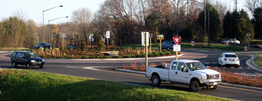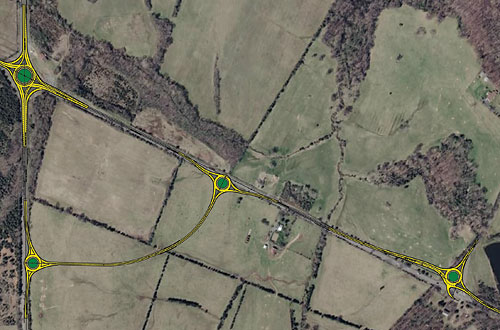
Should the Virginia Department of Transportation (VDOT) use its scarce transportation resources to bypass cities to relieve congestion? Or should VDOT invest in main street infrastructure that increases safety, preserves historic streetfronts, and grows local economies?
Panelists at the the Virginia Conservation Network‘s 2012 Virginia Environmental Assembly argued that more state transportation dollars should flow to making existing roads work better, rather than building new ones.
Chris Miller, President of the Piedmont Environmental Council, described how citizen activism reshaped VDOT planning for a historic segment of Route 50 passing Aldie, Middleburg, and Upperville, VA, in the foothills of the Blue Ridge Mountains. VDOT came up with the conventional solution: expand the road into a 4-lane, divided highway with bypasses around the small towns.
The citizens, however, had another vision: an innovative “traffic calming” plan that would address the problems on the roadway while promoting local business and protecting the rural and historic character of the area.
One of the most innovative sections of their approach design is a network of roundabouts replacing the conventional signalized intersection at the junction of Routes 50 and 15, said Miller. VDOT has been convinced, has already completed a of roundabouts at Gilbert’s Corner, at the intersection of Route 50 and Route 15. The agency will finish 3 other traffic calming projects in the area in the next few years.
The roundabouts also cost considerably less than the bypass idea. The plan, which has improved levels of service on Route 50 from D and E to A and B, cost around $17 million dollars. This is a fraction of the $450 million VDOT estimated for their original plan.
The state should take care to consider how to adopt this model to transportation challenges that it now tries to solves with expensive major projects, including a $250 million bypass for Route 29 near Charlottesville. That project has drawn criticism for its projected environmental impact, said Jim Bacon, who blogs at Bacon’s Rebellion.
State Senator Barbara Favola pointed out that by 2017, there will be no construction dollars remaining in the state of Virginia’s transportation budget. As transportation challenges mount, Bacon emphasized, the state needs to seek the best return on investment (broadly defined) for the transportation dollar.
One of the best returns would be great investing in smart growth. Northern Virginia contributes 44% of the state’s funding, while receiving only 7% of the state transportation pot, said Favola. Despite this, cities like Arlington have led the way with linked transportation and development planning and the provision of effective multimodal service, all paid for overwhelmingly by local funds.
VDOT should view the progress made in Northern Virginia as a model, not an outlier. Virginia can invest in a handful of major transportation projects, or it can invest in smart growth. It can’t do both.
Top image: Gilbert’s Corner roundabouts. Image from VDOT.

